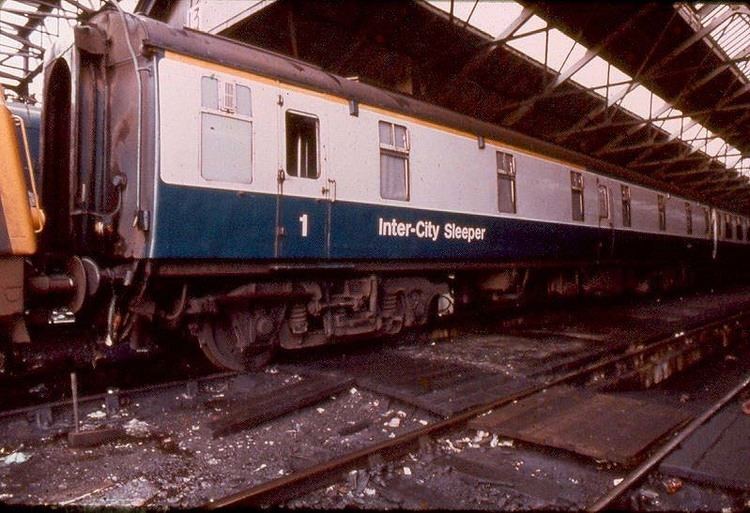Constructed 1957–1964 | ||
 | ||
Manufacturer BR Derby (C&W), Doncaster, Wolverton, York; Metropolitan Cammell Family name British Railways Mark 1 Number built 380 (133 SLF, 55 SLC, 192 SLSTP) Fleet numbers SLF: 2000–2132,
SLC: 2400–2454,
SLSTP: 2500–2691 Capacity SLF: 11 first,
SLC: 5 first and 12 second,
SLSTP: 22 second | ||
The British Railways Mark 1 sleeping car was a railway sleeping car built by British Railways and outside contractors between 1957 and 1964. Three hundred and eighty cars of three different types were built, with a fourth type created later by conversion. None remain in front-line service and very few are preserved (this was due to asbestos insulation in most carriages).
Contents
Design
Three types were designed, based on the BR Mark 1 63-foot (19.20 m) underframe and profile. All featured 11 compartments with side corridor, an attendants' pantry at one end, and two toilets at the other. There was one fixed berth in first class compartments and two fixed berths in second class. Thus the Sleeper First (SLF) slept 11 and the Sleeper Second (SLSTP) 22. The Sleeper Composite (SLC) had five first class and 6 second class compartments.
Early examples were fitted with BR1 bogies which were later replaced with B5 bogies. Later examples were fitted with Commonwealth bogies from new. The cars weighed 39 to 42 tonnes, with the First-class cars weighing one tonne less than the others, and cars with the fabricated B5 bogies also weighing one tonne less than those with the heavy cast steel Commonwealth bogies.
Modifications
In order to overcome the lack of flexibility in the fleet of sleeping cars, Wolverton works modified some of the SLSTP cars with a stowable top berth. The resulting Sleeper Either class with Pantry (SLEP) cars could then be used to better accommodate the fluctuations in passenger demand. The SLEPs were renumbered in the 2800-series.
Replacement
The Mark 1 sleeping cars fleet continued to serve British Rail for many years. With no Mark 2 sleeping car design, the Mark 1s continued until the British Rail Mark 3 sleeping cars entered service in the early 1980s.
Preservation
Several Mark 1 cars were bought by preservation societies for use as volunteer accommodation. When British Rail began to run down its overnight sleeper trains, many heritage railways replaced them with 'young' Mark 3 cars. Since most Mark 1 sleeping cars had been built with asbestos insulation, which was expensive to have decontaminated professionally, most were sold for scrap.
Those Mark 1 sleeping cars that survive have been decontaminated and are kept for their value as museum exhibits, as much as for sleeping accommodation.
No Sleeper Either class with pantry (SLEP) has survived, 1 Sleeper Composite exists with 6 Sleeper Firsts and 2 Sleeper Seconds.
